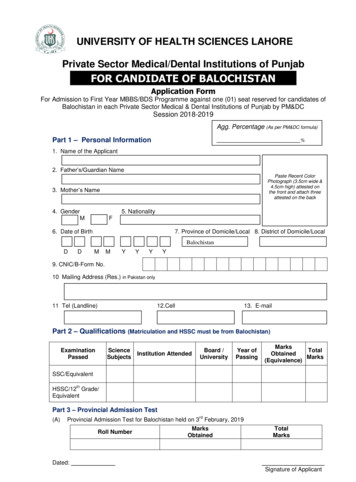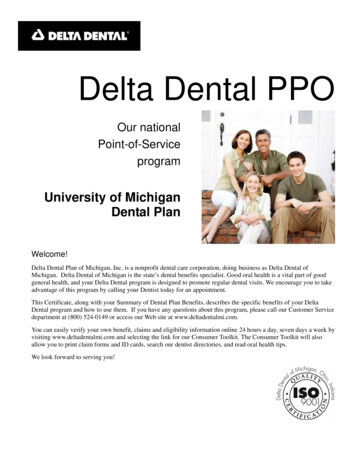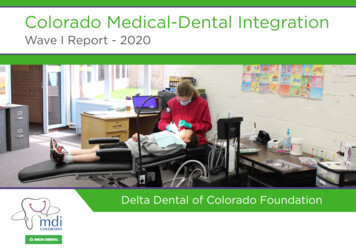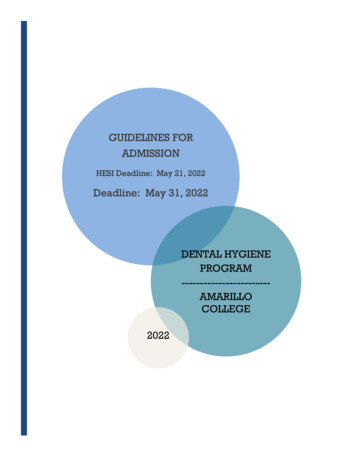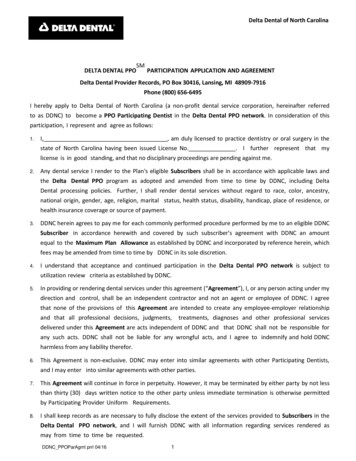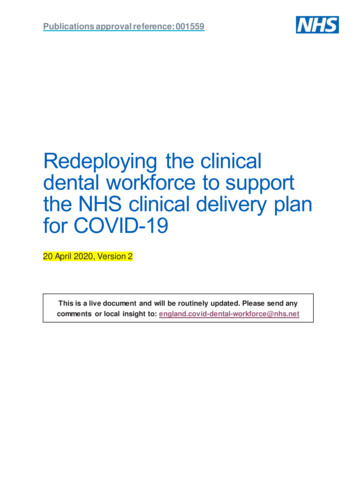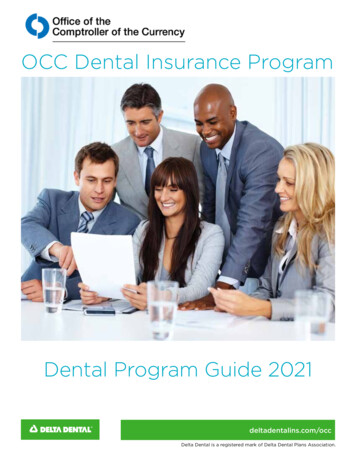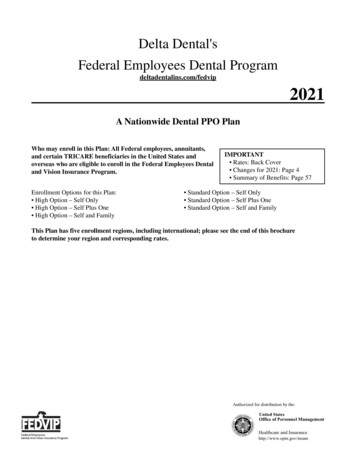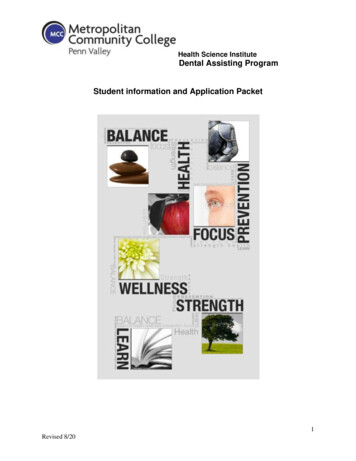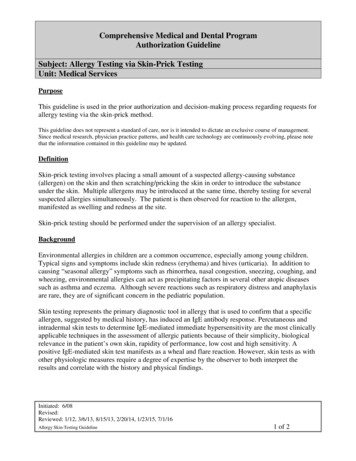
Transcription
Comprehensive Medical and Dental ProgramAuthorization GuidelineSubject: Allergy Testing via Skin-Prick TestingUnit: Medical ServicesPurposeThis guideline is used in the prior authorization and decision-making process regarding requests forallergy testing via the skin-prick method.This guideline does not represent a standard of care, nor is it intended to dictate an exclusive course of management.Since medical research, physician practice patterns, and health care technology are continuously evolving, please notethat the information contained in this guideline may be updated.DefinitionSkin-prick testing involves placing a small amount of a suspected allergy-causing substance(allergen) on the skin and then scratching/pricking the skin in order to introduce the substanceunder the skin. Multiple allergens may be introduced at the same time, thereby testing for severalsuspected allergies simultaneously. The patient is then observed for reaction to the allergen,manifested as swelling and redness at the site.Skin-prick testing should be performed under the supervision of an allergy specialist.BackgroundEnvironmental allergies in children are a common occurrence, especially among young children.Typical signs and symptoms include skin redness (erythema) and hives (urticaria). In addition tocausing “seasonal allergy” symptoms such as rhinorrhea, nasal congestion, sneezing, coughing, andwheezing, environmental allergies can act as precipitating factors in several other atopic diseasessuch as asthma and eczema. Although severe reactions such as respiratory distress and anaphylaxisare rare, they are of significant concern in the pediatric population.Skin testing represents the primary diagnostic tool in allergy that is used to confirm that a specificallergen, suggested by medical history, has induced an IgE antibody response. Percutaneous andintradermal skin tests to determine IgE-mediated immediate hypersensitivity are the most clinicallyapplicable techniques in the assessment of allergic patients because of their simplicity, biologicalrelevance in the patient’s own skin, rapidity of performance, low cost and high sensitivity. Apositive IgE-mediated skin test manifests as a wheal and flare reaction. However, skin tests as withother physiologic measures require a degree of expertise by the observer to both interpret theresults and correlate with the history and physical findings.Initiated: 6/08Revised:Reviewed: 1/12, 3/6/13, 8/15/13, 2/20/14, 1/23/15, 7/1/16Allergy Skin-Testing Guideline1 of 2
Comprehensive Medical and Dental ProgramAuthorization GuidelineSubject: Allergy Testing via Skin-Prick TestingUnit: Medical ServicesCriteria to Substantiate Medical Necessity for Allergy Testing:One or more of the following: Eczemao Requested by dermatologisto Prolonged use of topical steroids 4 continuous weeks, without resolution Steroids must be class V steroids or strongerFood Allergyo Requested by gastroenterologist, oro Etiology related to exposure to peanut or nut, oro Clearly delineates a true food sensitivitySeasonal allergyo Greater than six weeks of symptoms ando Failed trial of therapy with appropriate medications Compliance demonstrated by prescription records Must have documented appropriate follow-up with the medical providerAnaphylaxis or other life threatening allergic-type responseo Etiology related to environmental allergen exposureo Etiology related to exposure to peanut or nutRecurrent angioedema or chronic or recurrent hivesReferences:Sicherer, S., & Wood, R. A. (2011). Allergy testing in childhood: Using allergen-specific ige tests.Official Journal of the American Academy of Pediatrics, 129(1), 193-197.Signature on FileMedical Director7/1/2016DateInitiated: 6/08Revised:Reviewed: 1/12, 3/6/13, 8/15/13, 2/20/14, 1/23/15, 7/1/16Allergy Skin-Testing Guideline2 of 2
Comprehensive Medical and Dental ProgramAuthorization GuidelineSubject: CircumcisionUnit: Medical ServicesPurposeThis guideline is used in the prior authorization and decision-making process regarding requests forcircumcision.This guideline does not represent a standard of care, nor is it intended to dictate an exclusive course of management.Since medical research, physician practice patterns, and health care technology are continuously evolving, please notethat the information contained in this guideline may be updated.Routine Circumcision in the NewbornRoutine newborn circumcision is not a covered service by AHCCCS or CMDP, as of October2002.Non-routine circumcisionCircumcisions that are considered medically necessary by the healthcare provider require a priorauthorization by CMDP Medical Services. The request for authorization must be accompanied bydocumentation to substantiate medical necessity.BackgroundPhimosis is a constriction of the prepuce resulting in an inability to retract the foreskin back overthe glans. Developmental (physiological) nonretractile foreskin is very common in the toddler andyoung child. True phimosis (adhesion of the foreskin to the glans) is much less common. In 10%of uncircumcised 3-year-old boys, the foreskin cannot be fully retracted, but the foreskin willbecome fully retractable for nearly all the boys by the onset of puberty.Balanitis (inflammation/infection of foreskin) is not common and, if it occurs, it is not an absolutereason to perform a circumcision. Pediatric urologists follow many children and young menlongitudinally who do not desire circumcision, yet have repeated bouts of balanitis. This can besuccessfully managed medically (without surgical intervention).Initiated: 8/2003Reviewed: 4/2006; 1/2007; 11/2007; 06/2008; 1/2012; 4/10/13, 8/15/13, 3/13/14, 1/23/15, 7/1/16Circumcision Guideline 20161 of 2
Comprehensive Medical and Dental ProgramAuthorization GuidelineSubject: CircumcisionUnit: Medical ServicesCriteria to Substantiate Medical Necessity for Circumcision: True phimosis (vs. developmental/physiological non-retractile foreskin) in a boy older than6 years of age. True phimosis, which has failed an adequate trial of daily topical therapy (steroid therapy)for 4-6 weeks duration. [Betamethasone (a steroid cream) can be applied to gradually andgently break adhesions, if phimosis is a real concern.] Phimosis that has resulted in impaired urinary stream. Paraphimosis which causes the foreskin, once pulled back, to not return to its originallocation. Associated with other penile surgeryOther considerations may include: Balanitis or Balanoposthitis resulting in the need for repeated emergency department visits.Recurrent UTI’sReferences:American Academy of Pediatrics (AAP) 1971, 1975, 1983, 1989 and March1999, and 2011Cost-effective Treatment of Phimosis; RS Van Howe. Pediatrics 1998;102;43-46Postneonatal circumcision: population profile; GL Larsen, SD Williams. Pediatrics1990;85(5);808-812Circumcision in children beyond the neonatal period; TE Wiswell, et al. Pediatrics 1993;92(6):791793Signature on fileMedical Director7/1/16DateInitiated: 8/2003Reviewed: 4/2006; 1/2007; 11/2007; 06/2008; 1/2012; 4/10/13, 8/15/13, 3/13/14, 1/23/15, 7/1/16Circumcision Guideline 20162 of 2
Comprehensive Medical and Dental ProgramAuthorization GuidelinesSubject: Considerations for wart or other skin lesion removalUnit: Medical ServicesPurposeThis guideline is used in the prior authorization decision-making process regarding requests forremoval of warts or other skin lesions such as, but not limited to, molluscum, uncomplicated nevi ,keloids and skin tags.This guideline does not represent a standard of care, nor is it intended to dictate an exclusive course of management.Since medical research, physician practice patterns, and health care technology are continuously evolving, please notethat the information contained in this guideline may be updated.Routine skin lesion debridementWarts are a common pediatric problem, affecting 10% of the population at some time. Although itis impossible to predict the natural history of individual warts, studies conducted in childrenindicate that 66% of lesions resolve spontaneously within 2 years.A number of therapies exist, but the response to any given treatment method is variable.Among the most common treatments are the application of a keratolytic agent (e.g., thosecontaining salicylic acid) and cryotherapy (liquid nitrogen/freezing), each of which has an ultimatecure rate of only 75%. Adverse outcomes are reported to be more frequent and more severe incryotherapy.Complications of treatment include: Fear and discomfort that the child experiences,Complications such as blisters, infections and alterations of the pigmentation of the skin,Permanent scarring, andThe need for frequent clinic visits for successful treatment.The best available evidence supports the use of topical treatments that contain salicylic acid, whichcan be found in over-the-counter (OTC) products. Such preparations have been shown to have amodest, but significant, treatment benefit over placebo (no treatment). Studies have suggested thatthe application of adhesive tape/duct tape may also be as effective as or more effective thanconventional treatment. In one report, the application of duct tape produced a cure rate of 85%,which is more effective than cryotherapy and has no complications.Initiated: 4/2006Reviewed: 3/2007; 06/2008; 1/2012; 4/29/13; 8/25/14; 1/23/15; 7/11/16Considerations for Wart or Other Skin Lesion Removal Guideline 20161 of 3
Comprehensive Medical and Dental ProgramAuthorization GuidelinesSubject: Considerations for wart or other skin lesion removalUnit: Medical ServicesWart RemovalMedically necessary wart removal is a covered service for CMDP eligible members. Theprocedure requires prior authorization (PA) by CMDP when performed by a dermatologist. Themember’s healthcare provider must submit appropriate documentation to substantiate medicalnecessity. Medically necessary wart removal by primary care providers (PCP) does not require PA.All cases of warts should be individually assessed and the choice of therapy selected based uponthe age of the patient existence of pain or discomfort and the number, size, location, anddistribution of the warts.Considerations for Treatment: The child/youth is in some way symptomatic, i.e., has significant pain, bleeding and/orirritation from the warts or skin condition. The warts or skin condition is growing, or is in an area of the body where they are subject torepeated trauma. The warts or skin condition is spreading in a larger distribution. The child is causing irritation to the warts or skin condition and therefore possiblyincreasing the distribution of the warts or skin condition. The warts or skin condition are on the face especially near the eyes and causing impairedfunction (vision)Warts or skin condition can be a self-limited viral infection that will resolve spontaneously.Treatment, if at all, should be conservative to avoid unnecessary trauma to the child/youth andunnecessary scarring as a result of the treatment.ReferencesClinical Pediatric Dermatology – A Textbook of Skin Disorders of Childhood and Adolescence.Hurwitz. Second edition.Initiated: 4/2006Reviewed: 3/2007; 06/2008; 1/2012; 4/29/13; 8/25/14; 1/23/15; 7/11/16Considerations for Wart or Other Skin Lesion Removal Guideline 20162 of 3
Comprehensive Medical and Dental ProgramAuthorization GuidelinesSubject: Considerations for wart or other skin lesion removalUnit: Medical ServicesSanders Bellet, J. (2013). Developmental anomalies of the skin. In Seminars in Perinatology (2013ed., Vol. 37, pp. 20-25). Durhan, NC: Elsevier.Schneider, M., Meites, E., & Daane, S. (n.d.). Keloids: Which treatment is best for your patient:.The Journal of Family Practice, 62(5), 227-233.Sethuraman, G., Bhari, N., & Pandhi, B. (n.d.). Common Skin Problems in Children. Pediatrics inGeneral Practice, 81(4), 381-390.Signature on fileMedical Director7/11/2016DateInitiated: 4/2006Reviewed: 3/2007; 06/2008; 1/2012; 4/29/13; 8/25/14; 1/23/15; 7/11/16Considerations for Wart or Other Skin Lesion Removal Guideline 20163 of 3
Comprehensive Medical and Dental ProgramAuthorization GuidelineSubject: Consults by Developmental/Behavioral PediatriciansUnit: Medical ServicesPurposeThis guideline is used in the prior authorization and decision-making process regarding requests forconsultation by developmental pediatrician.This guideline does not represent a standard of care, nor is it intended to dictate an exclusive courseof management. Since medical research, physician practice patterns, and health care technologyare continuously evolving, please note that the information contained in this guideline may beupdated.BackgroundDevelopmental-Behavioral Pediatricians (DBPs) have special training which gives them expertisein the evaluation and treatment of children, adolescents, and their families with a wide range ofdevelopmental and behavioral difficulties. These include: learning disorders, attention andbehavioral disorders, tic disorders, regulatory disorders, discipline difficulties, developmentaldisabilities/disorders, autism spectrum disorders, and disorders related to chronic illness anddisabling conditions.There is much crossover in the expertise of the Developmental/Behavioral Pediatrician and thustheir services are now available through the public medial health plan (CMDP) and the behavioralhealth system (RBHA), depending on the nature of the child’s presenting medical problem.OverviewDepending on the nature of the clinical presentation, the DBPs may be consulted to provide servicethrough either public health system (medical or behavioral). In order for a DBP to participate as aCMDP provider, it will be imperative that they are registered as providers with both CMDP and theassigned RBHA providing the child’s care. In this way, they will be able to appropriatelycoordinate care between the medical and behavioral health systems.In general, health plans are responsible to provide medically necessary developmental serviceswhen the concerns expressed relate to developmental delays with physical health implications,including the need for outpatient therapy services. The RBHAs are responsible when the servicesfocus around behavioral issues, including the possibility of autism. The school districts areresponsible when the concerns affect learning ability and school performance, as well as theperformance of appropriate testing and the development of an Individualized Education Plan.Initiated: 8/12Revised: 6/5/13Reviewed: 3/20/14, 1/23/15, 7/1/16Developmental/Behavioral Pediatric Consults1 of 3
Comprehensive Medical and Dental ProgramAuthorization GuidelineSubject: Consults by Developmental/Behavioral PediatriciansUnit: Medical ServicesA request for consultation with a Developmental Behavioral Pediatrician (DBP) by CMDP must beinitiated by the child /adolescent’s Primary Care Provider who has completed a recent EPSDT,including the appropriate behavioral and developmental screening. The services, includingdevelopmental testing to be provided by the DBP must be expected to contribute to a diagnostic orfunctional determination that will contribute to a change in the treatment plan, which is anticipatedto improve the member’s condition.The role of the Developmental/Behavioral Pediatrician through CMDPSpecific referral questions for the consulting DBP that will influence the medical management ofthe child or adolescent and relate to developmental disabilities and/or complex medical issues.Examples include: Developmental disabilities including cerebral palsy, spina bifida, mental retardation, andvisual and hearing impairments.Regulatory disorders including sleep disorders, feeding problems, complicated toilettraining issues, enuresis, and encopresis. Enuresis could be appropriately treated by thePCP, DBP, or RBHA depending on the nature of the problem. Some issues, such asencopresis will be most successfully treated with joint input from the RBHA & medicalproviders.Tics and Tourette syndrome, unless the disorder is related to a behavioral healthmedication. That would be addressed by the RBHA.The role of the Developmental/Behavioral Pediatrician through the RBHAAgain, specific referral questions for the consulting DBP that could lead to necessaryrecommendations for behavioral health treatment. Examples include: Attention and behavioral disorders including attention-deficit/hyperactivity disorder,depression, and anxiety disorders. These disorders must be addressed by the PCP or RBHA.The DBPs can only be consulted by the RBHA in this scenario. CMDP will not pay a DBPto consult on behavioral health issues. Oppositional-defiant behavior, conduct problems, and discipline difficulties Autism Spectrum Disorders, other habit disordersInitiated: 8/12Revised: 6/5/13Reviewed: 3/20/14, 1/23/15, 7/1/16Developmental/Behavioral Pediatric Consults2 of 3
Comprehensive Medical and Dental ProgramAuthorization GuidelineSubject: Consults by Developmental/Behavioral PediatriciansUnit: Medical ServicesThe role of the educational systemThe educational system (AzEIP - for children under 3 years or the School District - for children 3years and older) is responsible for: The evaluation of delayed development in speech, language, motor skills, and thinkingability. The evaluation of learning disorders including dyslexia, writing difficulties, math disorders,and other school-related learning problems. Testing to determine if a child has intellectual disability (mental retardation).References:FREQUENTLY ASKED QUESTIONS DEVELOPMENTAL/BEHAVIORAL PEDIATRICIANSROLE AS PART OF ARIZONA’S PUBLICLY FUNDED BEHAVIORAL HEALTH df/DevelopmentalBehavioralFAQs.pdfsignature on file7/1/16Medical DirectorDateInitiated: 8/12Revised: 6/5/13Reviewed: 3/20/14, 1/23/15, 7/1/16Developmental/Behavioral Pediatric Consults3 of 3
Comprehensive Medical and Dental ProgramAuthorization GuidelineSubject: Cranial Banding (Cranial Orthosis)Unit: Medical ServicesPurposeThis guideline is used in the prior authorization and decision-making process regarding requests forcranial banding.This guideline does not represent a standard of care, nor is it intended to dictate an exclusive course of management.Since medical research, physician practice patterns, and health care technology are continuously evolving, please notethat the information contained in this guideline may be updated.BackgroundPlagiocephaly is a type of cephalic disorder characterized by an asymmetrical distortion (flattening)of one side of the skull. It is a common finding at birth and may be the result of a restrictiveintrauterine environment. If there is premature union of skull bones, this is more properly calledcraniosynostosis.Positional plagiocephaly, also known as deformational plagiocephaly, is a condition mostcommonly found in infants and is characterized by a flat spot on the back or one side of the headcaused by remaining in one position for too long. It can be caused by a condition called torticollisin which neck muscles on one side of the head develop differently, causing the head to tilt to oneside, but more commonly it happens in infants of ordinary development who sleep in one positionfor long periods of time. Prognosis for this condition is excellent and can be reversed in most casesbefore one year of age. Treatment can be as simple as repositioning the child's head while sleepingand increasing the time spent on the belly. In some cases, special fitted helmets can be used. Once achild starts moving on his/her own, the condition may improve by itself. The flattening of the head,while alarming, does not typically harm the brain or hinder its development.Brachycephaly refers to shortened antero-posterior diameter of the skull.Cranial Bands are usually made of an outer hard shell with a foam lining. Gentle, persistentpressures are applied to capture the natural growth of an infant's head, while inhibiting growth inthe prominent areas and allowing for growth in the flat regions. As the head grows, adjustments aremade frequently. The helmet essentially provides a tight, round space for the head to grow into.Cranial band use is ideally done between 4 months and 12 months of age and is designed to be usedfor approximately 2 – 4 months.Initiated: 6/08Revised:Reviewed: 1/12, 3/13/13, 8/15/13, 3/20/14, 3/5/15, 7/1/16Cranial Banding (Cranial Orthosis)1 of 3
Comprehensive Medical and Dental ProgramAuthorization GuidelineSubject: Cranial Banding (Cranial Orthosis)Unit: Medical ServicesAppropriate Patient SelectionCranial bands are considered medically necessary for moderate to severe positional headdeformities associated with prematurity, restrictive intra-uterine positioning, cervical abnormalities,torticollis and sleep positioning in children under certain circumstances:A two-month trial of conservative therapy has failedo Repositioning of child’s head away from the preferred sideo Treatment of torticollis with physical therapyo Documentation of pediatric visits and assessment by an experienced clinicianIf a two-month trial has failed, cranial orthotics may be instituted if one of the followingcriteria is met:For Plagiocephaly:Anthropometric data verifies that a moderate to severe plagiocephaly exists. (Data may be obtainedby orthotist).Asymmetry of greater than 6mm between anthropometric measurements of cranial base (sn – t),cranial vault (fz – eu), or orbitotragial (ex – t) depth warrant a trial of cranial banding.For Brachycephaly:A brachycephalic skull is relatively broad and short (typically with the breadth at least 80% of thelength). The evaluation for this consists of obtaining a cephalic index.Cephalic Index Head width (eu – eu) X 100Head length (g – op)Initiated: 6/08Revised:Reviewed: 1/12, 3/13/13, 8/15/13, 3/20/14, 3/5/15, 7/1/16Cranial Banding (Cranial Orthosis)2 of 3
Comprehensive Medical and Dental ProgramAuthorization GuidelineSubject: Cranial Banding (Cranial Orthosis)Unit: Medical ServicesA cephalic index greater than 2 standard deviations above or below the mean warrants a trail ofcranial banding.MaleFemaleAge-2SD-1SDMean 1SD 2SD16 days to 6 months63.768.773.778.783.76 - 12 months64.871.478.084.691.216 days to 6 months63.968.673.378.082.76-12 months69.574.078.583.087.5Other factors which may warrant cranial orthotic include:Premature infants with dolichocephalic head shape (a dolichocephalic skull is a relatively longskull, specifically having a cephalic index of 75% for females and 65% for males) secondary tosustained positionInfants with misshapen head secondary to constant head position required for hyperalimentationInfants with residual plagiocephaly after surgical correctionInfants with massive hydrocephalus who continue to have increasing head size despiteneurosurgical management with one or more Ventriculo-Peritoneal (VP) 0 399/0379.htmlDiagnosis and Management of Posterior Plagiocephaly. Ian F. Pollack, H. WolfgangLosken and Patricia Fasick. Pediatrics 1997;99;180-185.Prevention and Management of Positional Skull Deformities in Infants. John Persing,Hector James, Jack Swanson, John Kattwinkel, Committee on Practice and AmbulatoryMedicine, Section on Plastic Surgery and Section on Neurological Surgery. Pediatrics2003;112;199-202Signature on FileMedical Director7/1/16DateInitiated: 6/08Revised:Reviewed: 1/12, 3/13/13, 8/15/13, 3/20/14, 3/5/15, 7/1/16Cranial Banding (Cranial Orthosis)3 of 3
Comprehensive Medical and Dental ProgramAuthorization GuidelinesSubject: Criteria for Use of Recombinant Growth Hormone in ChildrenUnit: Medical ServicesPurposeThis guideline is used in the prior authorization and decision-making process regarding requests forRecombinant Growth Hormone (rGH).This guideline does not represent a standard of care, nor is it intended to dictate an exclusive course of management.Since medical research, physician practice patterns, and health care technology are continuously evolving, please notethat the information contained in this guideline may be updated.BackgroundResearch indicates that growth hormone (GH) alone, or in combination with anabolic steroids,improves the growth rate in children with growth hormone deficiency.Use of rGH in ChildrenThe CMDP Medical Management (MM) Committee recommends that rGH be used only for growthhormone resistant or deficient states and that it should only be prescribed and monitored by aPediatric Endocrinologist. Because of cost and potential side effects, prudent use is recommended.GH replacement for deficiency states: Classical growth hormone (GH) deficiencyInfants may present with hypoglycemia-related seizures, visual defects, ormicropenis. Acquired forms of GH deficiencyHead trauma – transection of pituitary stalk/injury to pituitary gland,intracranial lesions, irradiation therapy – greater than 2,400 rads of cranialradiation, therapy that is associated with abnormal spontaneous generation ofgrowth hormone.Patients are usually treated from 4 years of age through puberty. There is an expectation thatchildren should have a growth rate of / 5 cm (2 inches) per year.GH-resistant states with abnormal growth velocity of 5 cm/year, such as Chronic RenalFailure while awaiting transplantation: The goal is to maintain age-appropriate growth so that withthe re-establishment of normal GH responsiveness after transplantation, children might attain afinal adult height that is more consistent with their genetic potential.The response to rGH therapy in growth-resistant states should yield a growth rate of / 2.5cm/6months or / 5cm/year. The CMDP MM Committee recommends discontinuing rGH if the rateof growth is 5cm/year, generally around the chronological age of 12 or 13.Initiated: 08/2003Reviewed: 01/2005, 11/2005, 3/2007, 11/2007, 06/2008, 1/2010, 5/1/13, 4/24/14, 1/23/15, 7/1/16Criteria for Use of Recombinant Growth Hormone in Children Guideline 2016Page 1 of 3
Comprehensive Medical and Dental ProgramAuthorization GuidelinesSubject: Criteria for Use of Recombinant Growth Hormone in ChildrenUnit: Medical ServicesCriteria to Substantiate Medical Necessity for rGHThe child must have a diagnosis consistent with a GH deficiency state and the following criteriamust all be met: Use must be for an FDA-approved condition, The child must have proportionate short stature with height 5th percentile on astandardized growth chart, The child must have an abnormal growth velocity, as demonstrated on growth chart( 5 cm/year), The child must have a delayed bone age 2 SD from the norm, as compared withchronological age, The child must have failed a growth hormone stimulation test, with a peak 10micrograms/ml, and The child must have an absence of chronic disease, psychosocial dwarfism ormalnutrition.ORThe child must have a diagnosis consistent with a GH resistant state and demonstrate anabnormal growth velocity. Use must be for an FDA-approved condition, The child must have proportionate short stature with height 5th percentile on astandardized growth chart, The child must have an abnormal growth velocity, as demonstrated on growth chart( 5 cm/year),Once initial PA is received, continued authorization is required on a semi-annual basis. Must document compliance, annualized growth velocity, benefits of continuedtreatment.Considerations for Discontinuing rGH Therapy Decrease in growth velocity while on rGH therapy, i.e. 5 cm/year, Bone age of:o 14 years in femaleso 16 years in males Poor compliance, or Attained height of the child/youth that is within genetic potential, as defined bymidparental height:o For males ([mother’s height 13cm] father’s height)/2o For females ([father’s height – 13 cm] mothers height)/2Initiated: 08/2003Reviewed: 01/2005, 11/2005, 3/2007, 11/2007, 06/2008, 1/2010, 5/1/13, 4/24/14, 1/23/15, 7/1/16Criteria for Use of Recombinant Growth Hormone in Children Guideline 2016Page 2 of 3
Comprehensive Medical and Dental ProgramAuthorization GuidelinesSubject: Criteria for Use of Recombinant Growth Hormone in ChildrenUnit: Medical Services*(Calculations must be in cm)References:Review and update lecture to AHCCCS Medical Directors on June 27, 2003 by Dr. Khalid Hasan,Director Pediatric Endocrinology, Phoenix Children’s HospitalPCH Grand Rounds, Dr. Mahmoud Kabbani. Short Stature on November 15, 2005Kemp SF, Kuntze J, Attie KM, et al. Efficacy and safety results of long-term growth hormonetreatment of idiopathic short stature. J Clin Endocrinol Metab. 2005; 90:5247-5253.Leschek EW, Rose SR, Yanovski JA, et al. Effect of growth hormone treatment on adult height inperipubertal children with idiopathic short stature: a randomized, doubleblind, placebocontrolled trial. J Clin Endocrinol Metab. 2004;89:3140-3148.Hintz RL, Attie KM, Baptista J, Roche A. Effect of growth hormone treatment on adult height ofchildren with idiopathic short stature. N Engl J Med. 1999;340:502-507.Reiter EO, Price DA, Wilton P, et al. Effect of growth hormone (GH) treatment on the near-finalheight of 1258 patients with idiopathic GH deficiency: analysis of a large internationaldatabase. J Clin Endocrinol Metab. 2006;91:2047-2054; doi:10.1210/jc.2005-2284Wudy SA, Hagemann S, Dempfle A, Ringler G, Blum WF, Berthold lD, Alzen G, Gortner L,Hebebrand J. Children With Idiopathic Short Stature Are Poor Eaters and Have DecreasedBody Mass Index. Pediatrics 2005;116;e52-e57MMC Grand Rounds, Dr. Chirag Kapadia. Interpretation of Growth Curves in Children on January12, 2010.Signature on fileMedical Director7/1/16DateInitiated: 08/2003Reviewed: 01/2005, 11/2005, 3/2007, 11/2007, 06/2008, 1/2010, 5/1/13, 4/24/14, 1/23/15, 7/1/16Criteria for Use of Recombinant Growth Hormone in Children Guideline 2016Page 3 of 3
Comprehensive Medical and Dental ProgramClinical GuidelinesSubject: Frenectomy Indications for AnkyloglossiaUnit:Medical ServicesPolicy:This policy’s intended use is as a clinical guideline for determining m
Routine newborn circumcision is not a covered service by AHCCCS or CMDP, as of October 2002. Non-routine circumcision Circumcisions that are considered medically necessary by the healthcare provider require a prior authorization by CMDP Medical Services. The request for authorization must be accompanied by


